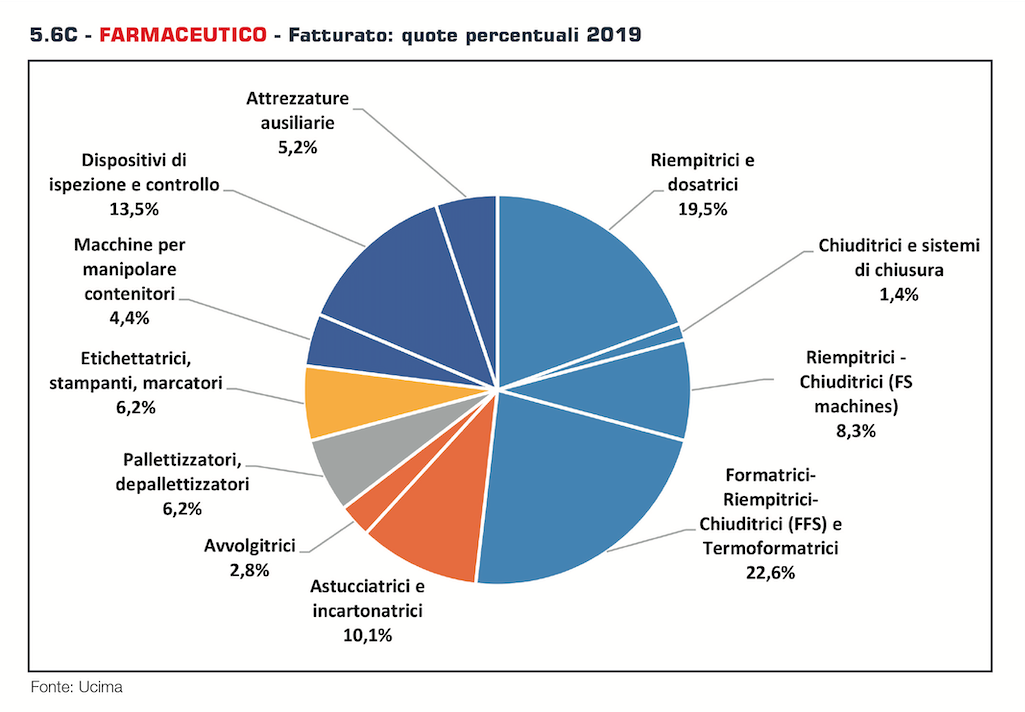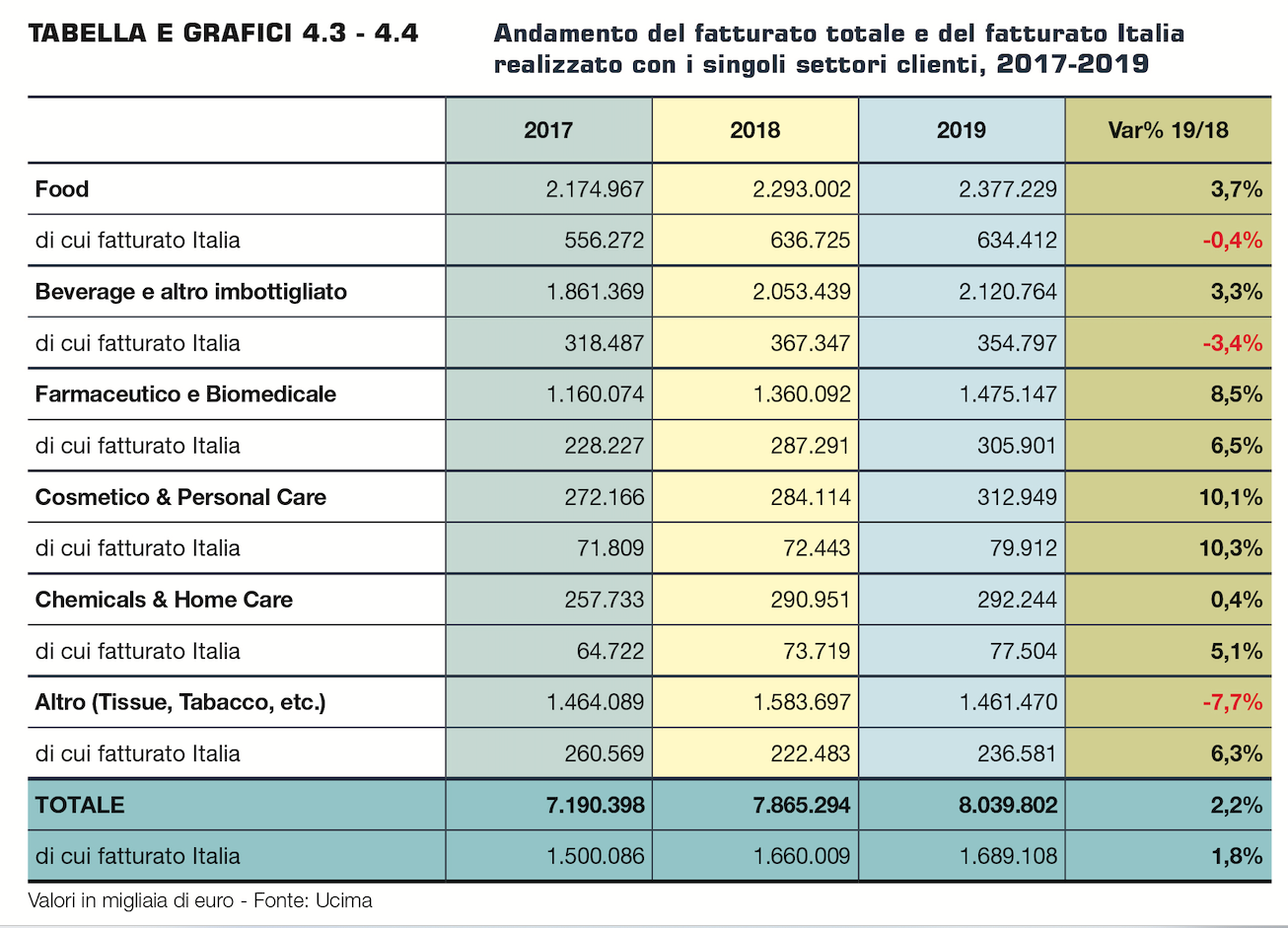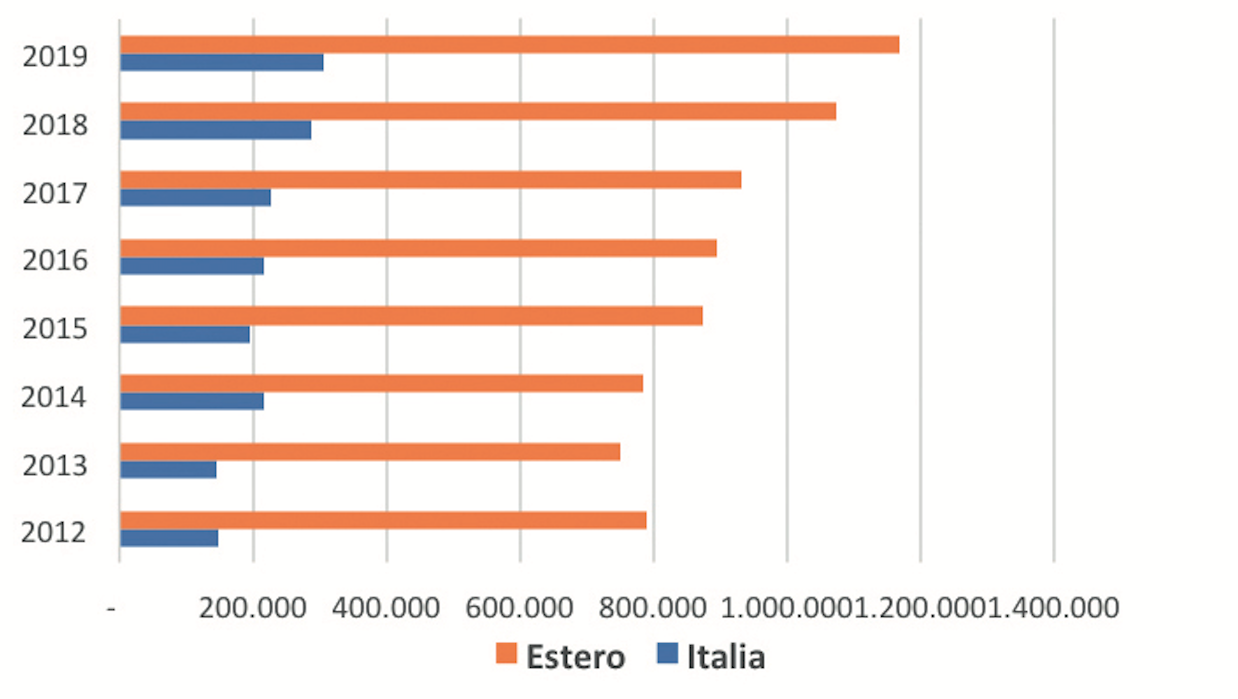Good 2019 for automatic machines
With the solidity of the Italian manufacturers of automatic packaging and wrapping machines confirmed for 2019 - where the growth of solutions for the pharmaceutical industry features - we look with a certain apprehension and a good dose of realism at the market evolution for 2020. Indicators from the Ucima Annual Statistical Survey. Milena Bernardi
 For 2019 the Italian market for packaging machines for food&beverage, cosmetic and pharmaceutical products confirmed growth trends.
For 2019 the Italian market for packaging machines for food&beverage, cosmetic and pharmaceutical products confirmed growth trends.
This was reported by the data expressed in the eighth national statistical survey prepared by the MECS - UCIMA Study Center, which shows a generally positive picture for the entire packaging machinery sector, which ended the year at +2.2 % (the only plus sign of the entire Federmacchine family, Ed.).
However, if we can still rejoice for 2019, it won’t be the same for 2020. As the drafters of the UCIMA survey in the introduction point out, this is unfortunately now a certainty: all the figures presented will in fact be drastically different from those contained in the next report, due to the collapse of the international indicators compared to those estimated in the recent past and with Italy bringing up the rear in every statistic in circulation.
The Covid-19 health emergency has therefore succeeded for the first time in reducing the expectations of a sector such as that of packaging machines which, by virtue of the very high diversification of the target markets and customer sectors, had always up to now borne the shocks of the prevailing market situation.
In the overview of the coming future, the pharmaceutical machine sector should be considered apart, due to its operating during the emergency and which, by virtue of its “essential” strategic function, will maintain the good positions acquired also in the future.
Data of an evolution
The industrial sectors operating in the production of capital goods, represented by Federmacchine, in 2019 generated a total of 35,671 million euros, a result down 3.9% compared to 2018, the year in which the turnover had reached 37,117 millions.
In this context, the Italian automatic packaging machine manufacturing sector has once again demonstrated its solidity and, for the fourth year in a row, has achieved positive performances, ranking first in terms of exports and second in overall turnover.
According to Ucima’s findings, the sector’s turnover (616 companies with 33,304 employees) reached 8,040 million euros (22.5% of total turnover), up 2.2% on the previous year, the only plus sign the whole Federmacchine family.
The export share rose to 79%, with a value of 6,351 million euros (+2.3%), but also maintained the domestic market, which recorded a +1.8% (1,689 million of Euro).
Performance by target sectors
In the division of turnover between the various customer sectors, 2019 confirms a predominance of the food industry as a whole (food +beverage), which accounts for 56% of the total turnover. The two sub-sectors are also confirmed individually at the top of the ranking: food is the first customer sector, absorbing 29.6% (2,377 million euros) of total turnover, with a 73% propensity to export. Beverage ranks second (2,120 million), absorbing 26.4% of the total turnover with sales destined for 83% to foreign markets.
The market for pharmaceutical machinery follows by volume, with 1,475 million euros billed in 2019, 79% of which were made on international markets.
The “other” sector (tobacco machines, tissue, etc.) reaches 1,461 million euros (18.2% of the total), and shows the highest export propensity among the downstream sectors, equal to 84%.
The chemical and cosmetic sectors close the ranking, with a turnover of 292 and 312 million euros respectively, but with lower export propensities, in line with that of the food sector (73% and 74%).

Pharma machines: the details
After cosmetics, the sector of packaging machines for the pharmaceutical sector is confirmed as the one with the most evident growth both in Italy and abroad. Cross-border sales exceeded 1,169 million euros (+9%), while in Italy volumes amounted to 305,901 million (+6.5%).
The weight of the sector on the total turnover (all customer sectors) is 18.3%. As can be seen from table 4.3, the trend of the three-year period has shown itself to be constantly growing: in 2019 the increase was 8.5%, in 2018 by 17.2%, in 2017 by +4.1%.

The most sold: molding-filling-sealing machines
Ucima’s analysis also examined the performance of the individual types of machines which, with regard to the Pharma category, were almost all growing.
With 333.7 million euros (291 in 2018), the most sold are the molding-filling-sealing (SBB) and thermoforming machines, followed by filling and dosing machines (287.3 million against 256.6).
On the third step of the podium the inspection and control devices at 199.1 million (they were 241.5 in 2018), while the fourth place is occupied by cartoning and casepacking machines (148.7 million and 131.3 in 2018).

Filling machines and sealers (FS machines) conquered the fifth position with 122.9 million euros (113.3 the previous year).
Followed in order of turnover labeling machines, marker printers (91.2), palletizers and depalletizers (90.9), auxiliary equipment (76.1), machines for handling containers (64.3), winders and closers respectively at 40.8 and 20.2 million euros.

Export areas: EU on the podium. To better understand the huge leap made by the sector, it is necessary to go back to 2014, when the export of Italian machines for pharmaceutical packaging was worth 784.827 million euros. In 2019, the turnover generated abroad rose to 1,169,246 million, a good 584,623 million more, a result that highlights the transversal strength of Italian technology on foreign markets, from Europe to Oceania. Going into the merits of the individual destination countries, last year the EU, the number one commercial outlet, generated 41.6% of the turnover of 485,855 million, slightly down on 2018 which had closed at 493,599 million. The Asian area grew with 300,449 million (+29.9% on 2018), as well as North America, the third target market, where sales rose to 131,825 million (+8%). The non-EU countries follow in order of turnover with 113.405 (-3.9%), South America (79.409 million, +33.5%), Africa (48.184 million, +17%) and finally Oceania at 10.117 million; +41.4%).




















